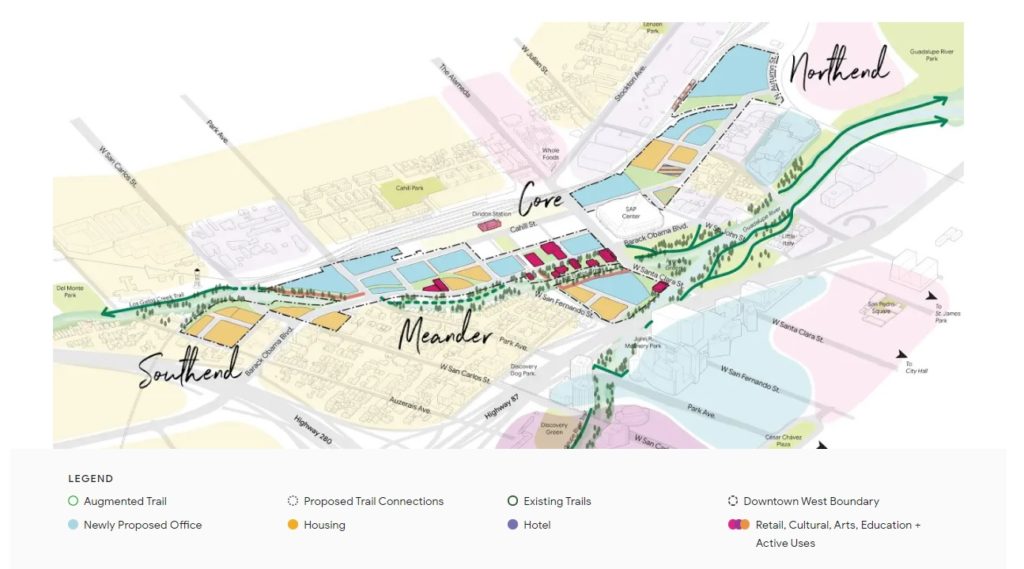Google is coming to downtown San Jose and it’s bringing 4,000 housing units with it. But making sure that a quarter of those units are affordable will be difficult.
The biggest obstacle to building affordable housing, city leaders say, is the high cost of land.
“The great thing about the Google model is that they’re not just giving the city money,” Mathew Reed, housing policy manager at Silicon Valley at Home, told San José Spotlight. “They’ve actually made sure there’s going to be space for that housing within the plan.”
The San Jose City Council last month approved Google’s 80-acre Downtown West project, in addition to the Diridon Affordable Housing Implementation Plan, which introduced over a dozen recommendations for developing denser housing in the Diridon Station area. That plan will support the construction of up to 13,519 additional residences.
The city and Google will mainly rely on the Diridon plan to help guide affordable housing policy in that portion of downtown. According to a city presentation, the plan aims to present an “equitable” and “accessible” approach by increasing opportunities for walking and biking, as well as opening up housing to more low-income applicants.
“I like to think of housing as the heart of an equitable development plan,” Jackie Morales-Ferrand, the city’s director of housing, said at last week’s council meeting. “Having a home or being able to remain in your home is key in making sure our residents thrive.”


The plan draws from a citywide residential anti-displacement strategy approved last September using what the city calls its “3P strategy:” Production, preservation and protection of current and future affordable housing developments.
Production will prioritize construction of affordable units through public and private contributions, preservation will permanently designate existing lower- and moderate-income housing for affordability and protection will prevent displacement of current tenants.
Some of the plan’s specific items require future council approval.
Google offered the city four plots of land to build about 800 affordable housing units and will pay an estimated $87 million in commercial linkage fees, a per-square-foot fee on office and industrial buildings to fund affordable housing.
As part of its agreement with the city, Google committed $1 billion through a community stabilization fund with a portion to be used toward the city’s protection and preservation strategies.
The company also agreed to $200 million in community benefits that won praise from both labor and business groups. Approximately $155 million of that fund will go to affordable housing initiatives, job training and homelessness prevention—one of the largest such agreements between any tech company and the city.


While labor groups, business groups, housing nonprofits and the vast majority of San Joseans asked in a Silicon Valley Leadership Group survey support the Downtown West project, some activists, such as Affordable Housing Network of Santa Clara County President Sandy Perry, still oppose the plan.
“Google has the ability to solve our homelessness problem,” Perry told San José Spotlight. “I’m not saying they should do it alone… but there’s no excuse to have this kind of money side by side with this kind of misery and destruction and pain.”
According to Santa Clara County’s latest homeless census published in 2019, 6,172 homeless people live in San Jose, an increase of 1,822 over 2017. The survey tallied 9,706 unhoused residents countywide—up from 7,394 individuals two years ago.
Perry is concerned that even with Google’s 4,000 units, it won’t be enough for the influx of 25,000 workers who will want to live in the area. Instead, he said, the lack of housing to meet demand will only make the crisis worse.
The city isn’t looking to touch any existing low-income housing in the Diridon area, and is also looking to keep the same number of deed-restricted units—homes reserved for low- to moderate-income earners—through 2040.
City officials are also looking to expand tenant protections, including a rule requiring that landlords have reasonable grounds for eviction—known as just cause evictions.
Google is set to transfer land to the city for one of its planned affordable housing developments, and will also provide an additional $3 million within the next month.
Officials are set to come back with a work plan for how to implement affordable housing in the fall.
“The demand for affordable housing is going to be significant,” Reed said. “It’s not going to be cheap to build at the (Diridon) station area… It’s going to take some work to put all the pieces together, but we’re hopeful that things will be in place to live up to the affordable housing commitment going forward.”
Contact Lloyd Alaban at [email protected] or follow @lloydalaban on Twitter.



Leave a Reply
You must be logged in to post a comment.